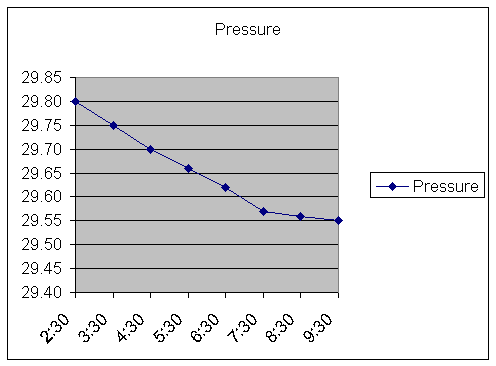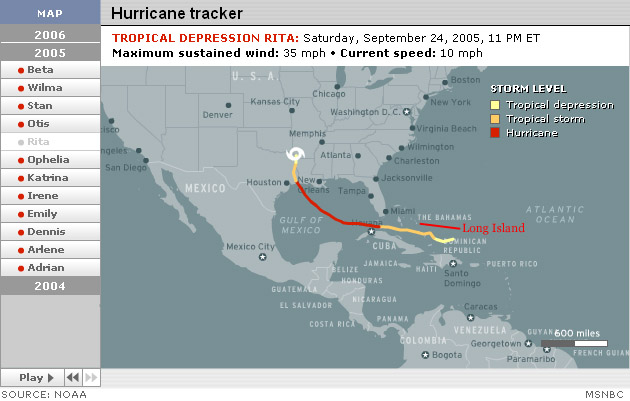Friday September 16, 2005. At long last, the new engine is installed. Today I move the Sirius II off the government dock, over to the Marina, about 400 yards away, for fuel ($4.18 a gallon) and water (30 cents a gallon). Then, another ľ mile to anchor for the night, to wait out the passing front that is forecasted.
Saturday September 17, 2005. I depart Clarence Town o/a 8:30. The seas are a little sloppy, but I assume this to be the effect of the tropical wave somewhere to the south by Hispaniola. Mechanically, the Sirius II seems sound. The new engine is purring nicely. But, can you believe this? A new problem. The auto pilot malfunctions. It will not keep the Sirius II on a straight course.
Because of this, my destination is just 27 miles, to the south end of Long Island, where I drop anchor in about 10 feet of water on the lee side. Initially, the anchor lands in a rocky patch and it soon begins to drag from rock to rock. I let it drag while I eat lunch (spam sandwich with tomato and onion), then I reset, dropping the anchor right on top of the anchor symbol on the chart. It works! Here is a nice sandy patch for the anchor to catch and dig in.
At nightfall I am joined by a gaff rigged Haitian boat, headed for Haiti I presume. (The Bahamans say they have their own illegal immigration problem--with Haiti.) I try to catch the evening weather report on the local radio station, but as usual the weather reporter is hard to understand. The report appears to confirm what I thought I heard earlier: A weather disturbance is indeed moving this way. A local fisherman comes by, who recognizes the Sirius II from her lengthy stay in Clarence Town. His advice is that I head back to Clarence Town first thing in the morning. The tropical wave is building into a storm.
In the morning I weigh anchor to return to Clearance Town, but find 30-knot winds and 10 feet waves waiting me on the windward side. Since I no longer have an autopilot to relieve my stay at the helm, I return to last nightís anchorage to wait out the weather.
The Haitian boat has left, to where I know not. Now I learn that this weather disturbance has a name: Tropical Storm Rita. Throughout the day the winds increase. I begin to wonder if I made the right decision to return to this anchorage. I keep looking at the four boats aground along the shoreline. Ominous indeed. I notice that my anchorage is very close to a shoal and elect to move to the anchorage ľ mile to the north. I lay out two anchors now, again on top of the anchor symbol. I test each anchor individually by backing down to ďsetĒ it firmly. Both are solid
Initially, the boat stays in the calm water protected by the leeward shore. During the night the wind shifts to the north, pushing the boat a little inward toward shore. About 3:00 a.m., as the winds increase to storm intensity, and the boat seemingly getting closer to shore, I start the engine in the event the anchors no longer hold and I will have to leave immediately.
Winds are gusting to 50 knots. I don a life jacket, for only the second time in 10 years of blue water cruising, and keep my eyes glued to the instruments that tell me my exact location. My mind begins to calculate how much of a casualty loss I can claim on my 2005 Federal Income Tax Return if the Sirius II goes aground. I guess that I am assuming that I will survive!
The dawn comes and I tune in to the local radio station to get the weather report. But today is Sunday and the station does not interrupt its church broadcasts to give a report, other than to say ďstay tuned for an update on Tropical Storm Rita.Ē
 Sometime around 8:00 a.m. the winds abate
somewhat. I feel a little relieved. The worst is over! I am still alive.
And the boat is still afloat. Within the hour, however, I begin to wonder
what is going on. I had been tracking the barometric pressure since 2:30
a.m. Here is the pattern:
Sometime around 8:00 a.m. the winds abate
somewhat. I feel a little relieved. The worst is over! I am still alive.
And the boat is still afloat. Within the hour, however, I begin to wonder
what is going on. I had been tracking the barometric pressure since 2:30
a.m. Here is the pattern:
If the storm has gone past my area, why is the barometric pressure still falling?
Soon, I have my answer. The winds all of a sudden increase with a vengeance, but now from the west and then the south-southwest. I didnít realize that a tropical storm has the same characteristics as a hurricane, i.e., the storm has an eye to it and while it passes over the wind is reasonably calm. And I am in the eye! The storm is that close. When the eye passes, the wind switches direction! The leeward shore has now become the windward shore. I no longer can stay here as the wind is blowing me toward shore.
It takes nearly an hour of bruising agony to raise one anchor and secure it on the bow. I know I canít raise the second anchor. Even if I could, the boat would be ashore before I could get back to the cockpit. I cut the line, leave the anchor where it is, and rush back to the cockpit as fast as my tether will allow me.
 At this point I can no longer remember if
the engine had already been engaged or not. At any rate, I maximize the
engine speed and head the Sirius II directly into the wind. Donít
let me down now, old girl.
At this point I can no longer remember if
the engine had already been engaged or not. At any rate, I maximize the
engine speed and head the Sirius II directly into the wind. Donít
let me down now, old girl.
The first Ĺ mile is directly into the wind, with gusts now well over 60 knots. By the time I reach the point to turn east, the seas are 20 feet or more. I have no sense of time, but guess it must have taken an hour to round the point. There is no way for me to leave the helm to check the chart, but the boats awash on the shore keep me aware of my position. I wonder again if I might join them.
How to make my turn to the north without coming broadside to the wind? In these conditions, this would be a sure knockdown. I calculate the timing of the waves so that I am directly on the crest when I make my turn, then quickly turn while the boat falls off into the trough, and have my new direction set before the next wave. I see all of this in my mind, but can I do it?
Thatís what I do and it works like planned. A small thing, but it makes me feel a lot better about my chances of survival.
 Once around the point, I have the comfort
of following seas on the leeward side, which are still in excess of 15 feet,
all the way back to Clarence Town. As it is Sunday, there is no one around
to assist me at the marina or the government dock. I gingerly bang the boat
into ugly black tires at the end of the government dock. Using these same
tires as steps, I climb onto the pier and secure the boat lines unassisted.
Of course, after spending over 48 hours on a pitching, rolling boat, what do
I do? As soon as my feet land on the pier, I fall on my butt. Hard. But,
I donít drop the line. With the bow made fast to the pier, I limp about
tying off the other lines at a more leisurely pace.
Once around the point, I have the comfort
of following seas on the leeward side, which are still in excess of 15 feet,
all the way back to Clarence Town. As it is Sunday, there is no one around
to assist me at the marina or the government dock. I gingerly bang the boat
into ugly black tires at the end of the government dock. Using these same
tires as steps, I climb onto the pier and secure the boat lines unassisted.
Of course, after spending over 48 hours on a pitching, rolling boat, what do
I do? As soon as my feet land on the pier, I fall on my butt. Hard. But,
I donít drop the line. With the bow made fast to the pier, I limp about
tying off the other lines at a more leisurely pace.
Within the hour some of the local fishermen, realizing that I am no longer at South Point, gather at the pier where, even in the protection of the bay, the wind is still whipping in excess of 30 knots. They donít do much more than stare at me. They are amazed that anyone would be, or could be, out in weather like this. So am I. At least I didnít join the other boats hard aground.
Throughout the week I repair lines, straighten out the cabin (everything that could have fallen to the cabin floor, did), reinstall the raw water strainer (it had broken loose during the storm), and talk daily to the Raymarine technician in New Hampshire about the auto pilot control unit. As he has just had it on his workbench less than two months ago, he is convinced that the control mechanism is OKóit must have lost its calibration (these things happen, you know). It just needs to be recalibrated, which requires a fairly calm sea. This does not occur until Friday. I take the Sirius II out three different times, each time implementing a more complicated calibration mode. By the end of the day he finally admits that there must be something wrong with the unit!
Saturday I wait for Andrew to come by to re-measure and then reset the prop alignment. As I expected, it was out of alignment.